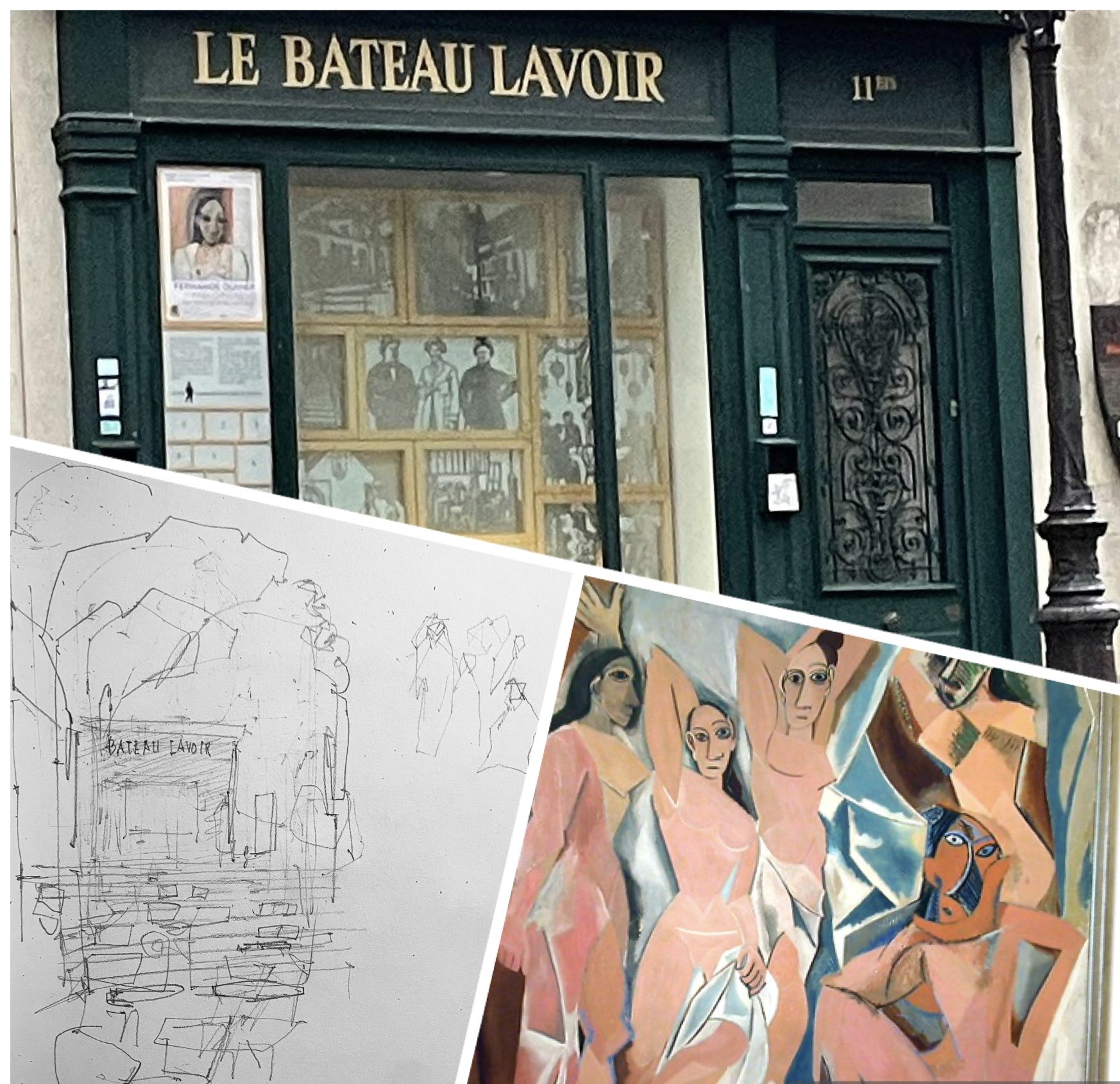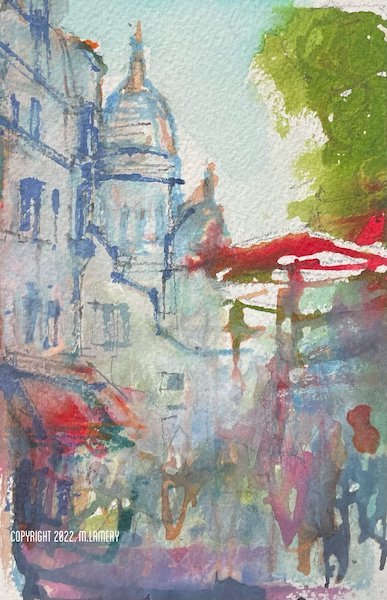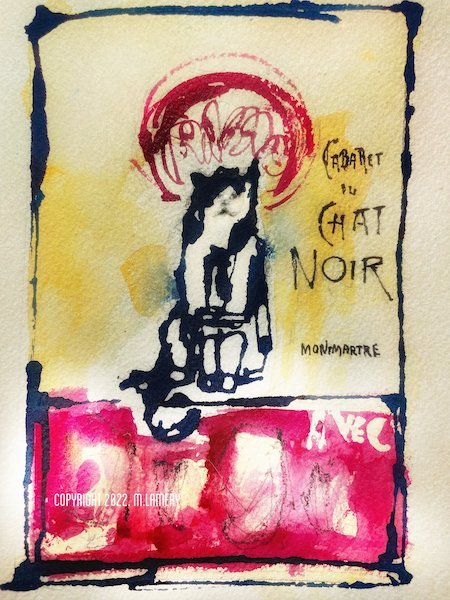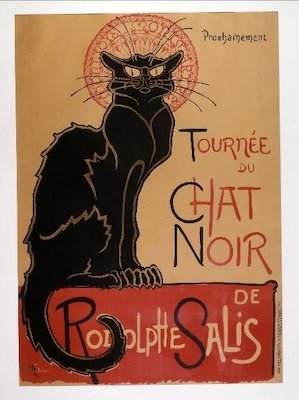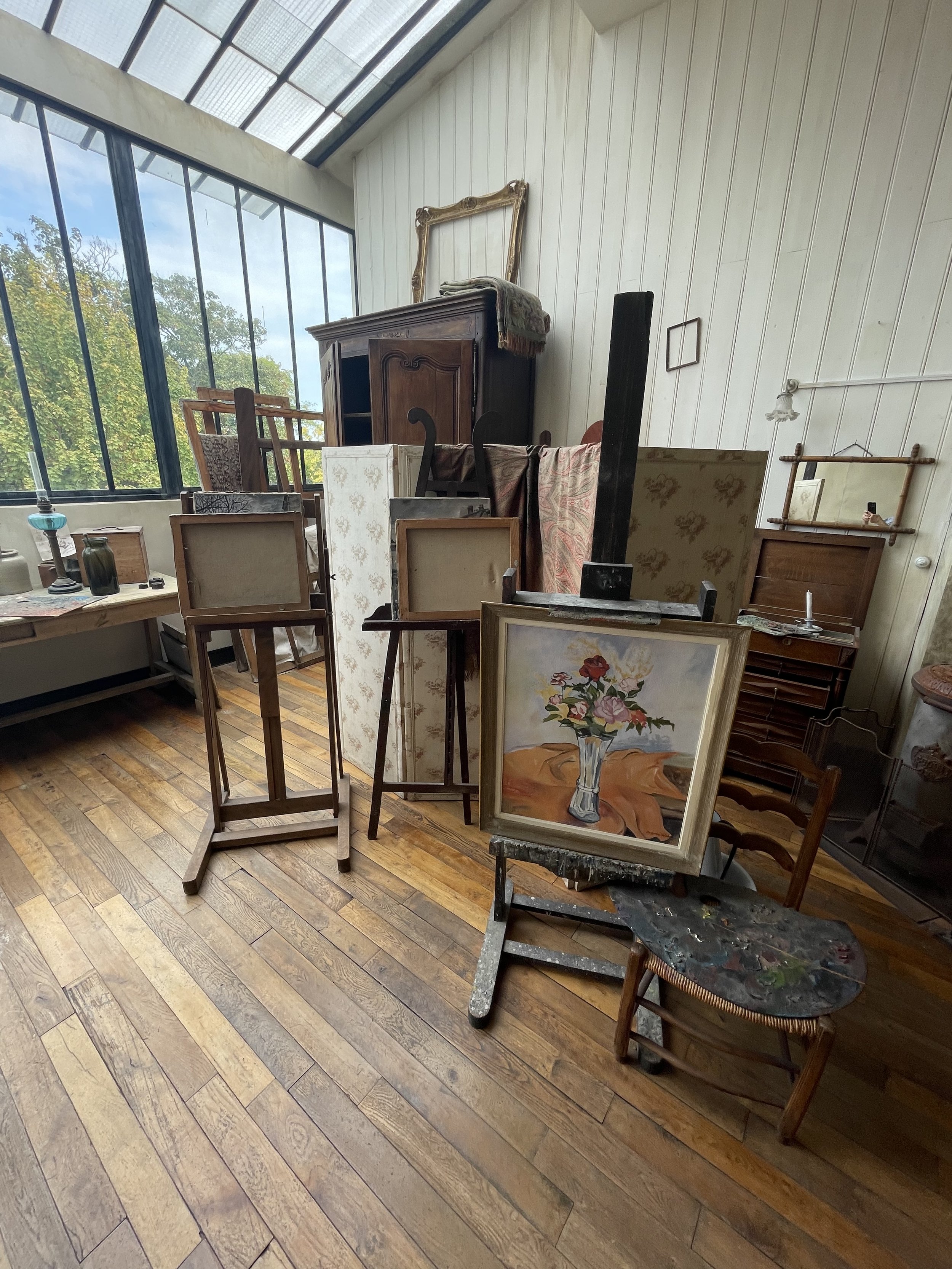Montmartre is a bustling neighborhood that sits high above the city of Paris on a butte where its storied history of vibrant cafes, theatre, and restaurants continue to enchant and delight to this day.
Before it was annexed to Paris in 1860, Montmartre was a rural village filled with orchards, vineyards, and windmills. There was no Basilique de Sacré-Cœur sitting at the top of the butte. Unpaved dirt roads winded around the butte, and the homes were simple and often dilapidated. The people who lived and worked in Montmartre were often poor and poverty stricken. With all these challenges of daily llfe, the people of Montmartre, the Montmartois, exhibited a sturdy sense of identity relative to their Parisian neighbors who lived far below the butte. They celebrated life in their rambunctious cafes and cabarets.
It wasn’t too long after its annexation to the Paris that Montmartre attracted the imagination of creative people of all types to its eclectic setting and spirit of independence. By the end of the 19th century and beginning of the 20th century, Montmartre cemented its reputation as an artistic mecca for painters, musicians, performers, and writers.
“Place du Tertre.” 4x6.” Here is a postcard I made in October 2022 capturing artists working in the square Place du Tertre surrounded by onlookers and tourists passing by.
When I am in Montmartre, I imagine the great Impressionist painters and writers and musicians that lived in this historic section of the city at the end of the 19th century. I try to imagine people like the painters Vincent Van Gogh and August Renoir and Henri de Toulouse-Latrec who created one of the iconic images of the gaiety of Montmartre—his lithographs of the Moulin Rouge, walking the same streets as I, passing the same landmarks as I.
I’m taking a coffee (café allongée) at the Musée de Montmartre. The museum is situated in the oldest house in Montmartre built in the 17th century. You can see a few of the spires of Sacré Cœur in the background. October 2022.
I imagine the creatives hanging out in cafes ringing the Place du Tertre at the very top of the butte drinking coffee and stronger beverages entrenched in conversation.
I guess you can call it an exercise in a little bit daydreaming, imagination, and magical realism.
I then factor in the paradigm shifts wrought by time recognizing that I come from a very different era. Yet, I experience a liveliness which I am convinced transcends time and eras. It is the spirit of Montmartre the lives and which prevails.
I am lured in by its history to want to know more about this hamlet of the city of Paris. So, I took my sketchbook and ventured out to explore.
Following is a little tour of Montmartre through artwork inspired by my recent visits to Paris. These images are featured in my 2023 postcard/calendar “Montmartre, Paris, France.”
Today, we will begin our tour at the top of Rue Lepic at the top of the butte. Rue Lepic winds around and around from the top of butte of Montmartre down to the foot of the hill, passing along the way, the building where Vincent Van Gogh lived with his brother Theo. Rue Lepic terminates at the Rue des Abbesses where there are a plentitude of cafes and restaurants and a wall dedicated to Love.
January
“LE MOULIN DE LA GALLETTE”
Le Moulin de La Gallette
At the top of the Rue Lepic is Le Moulin de la Galette, the restaurant. A little ways down, is the gated entrance--also called the Moulin de la Galette--that has one of the last remaining windmills, Le Moulin Blute-Fin, behind its locked gates. One can only see the windmill blades and sometimes, depending on what time of year it is when the leaves don't fill the trees, an outline of the old mill itself.
From this viewpoint, you are looking down the Rue Lepic about a block from the restaurant Moulin de La Gallette.
Montmartre was once a tiny independent village full of windmills, around 15 windmills total on the Montmartre butte. The windmills were always busy back in the day as they were used to grind wheat for bread (the "gallette,") to press grapes, and make to make materials for factories.
There are two remaining windmills today, both located on Rue Lepic: the Radet (built in 1717) and the Blute-Fin (built in 1622.) The Moulin Radet is the mill that tops the restaurant, “Le Moulin de la Gallette.”
I Love You Wall.
February
“I LOVE YOU” WALL
“Le mur des je t'aime.”
Located in the Square Jehan Rictus off of the Square des Abbesses you will find a little park with a wall on the side of a several story building made of tiles.
Created in 2000 by the artists Frédéric Baron and Claire Kito, "Le mur des je t'aime (I love you : the wall) is a place of reconciliation, a mirror which reflects an image of love and peace downtown Paris Montmartre, in France."
The project began when artist, Frédéric Baron, asked various individuals--acquaintances and neighbors, to write ‘I love you’ in their mother tongues. He wandered about Paris asking people how they express these words. He collected about a thousand different ways people say this simple phrase and kept his notes of the responses in various journals. The calligrapher Claire Kito convinced Baron that this collection could serve a greater audience. Kito was tasked with making the calligraphy of the words into glazed enamel plates of 250 different languages that declares love to all in a public setting in a small garden in Montmartre, Paris.
The result was placed on a wall. Why a wall? Baron is cited as saying, "a wall is not only a symbol for division and separation (especially in a world such as our own), but that it can also be a place to serve as a home for beautiful human feelings.
Place du Tertre, Montmartre.
All 192 nations that make up the United Nations are represented on the wall of "I Love You."
March
“PLACE DU TERTRE”
Place du Tertre is a public square located at the top of the butte of Montmartre.
The square has a history of attracting artists to its outdoor cafes and restaurants, once frequented by artists who lived in Montmartre back in the day such as Vincent Van Gogh, Henri Toulouse-Lautrec, Pablo Picasso, Camille Pissarro, and so many others.
This is a view of Sacré Cœur from Rue Lamarck.
In modern times, Place du Tertre continues to attract artists who set up their easels and sell their works in the square which is ringed with many of the same cafés and restaurants as in yesteryear, an attraction that makes the location one of the most visited places in Paris.
April
“SACRÉ CŒUR”
La Basilique du Sacré Cœur de Montmartre, opened in 1875, sits on the top of "la butte," the hill that towers over the city of Paris in the 18th arrondissement (XVIIIe arrondissement,) one of 20 arrondisssements or districts of Paris.
One thing that is unmistakable about this area: the omnipresence of Sacré Cœur that towers over the region.
May
“LA MAISON ROSE”
La Maison Rose.
La Maison Rose, named for the color of the building, is one of the oldest cafes in Montmartre. The building was constructed circa 1850. In 1905, it was purchased by Spanish painter Ramon Pinchot. It was eventually converted into a restaurant by Pinchot’s wife, Germaine Gargallo, who was an artist’s model.
It has been said that La Maison Rose got its iconic pink facade when Gargallo decided to get it repainted after being inspired by her trip to Barcelona, Spain.
There is a story that a subsequent owner painted the pink cafe white. It didn’t go over well. Following the protestations of the locals, that particular owner of the building re-painted the building in its original pink paint.
La Maison Rose is captured in millions of images by tourists. Before the camera, artists loved to paint the building, immortalizing it in their artwork. One painter, Maurice Atrillo, born in Montmartre painted the building, made a famous painting of the building called “The Little Pink House.”
La Maison Rose sits on the corner of Rue Cortot and Rue des Saules, just down the street from Musée de Montmartre on Rue Cortot.
Carousel de Saint-Pierre.
June
“CAROUSEL DE SAINT-PIERRE”
Seen from the lower grounds of Sacré Cœur.
Carousels are a French invention originating from the time of Louis XIV. Carousels became a thing at around the beginning of the 1900s, when the mechanics and public interest were at their zenith, thus dubbing the era the the "golden-age"of carousels in France.
The carousels turn counter-clockwise so that the little children can wave with their right hand. Carousels are everywhere in Paris.
There are approximately twenty or so carousels in the city. One such carousel is at the foot of Montmartre on the Place Ste. Pierre near the Rue des Abbesses. It is Italian made with a Venetian theme featuring bobby horses and carriages, spinning tea cups, and benches for those who just want a more sedate ride.
“Le Jazz.” Montmartre.
July
“LE JAZZ”
Jazz is a big deal in Paris. American Jazz in particular. More specifically, American Jazz from the early 20th century. To put a finer point on it, the jazz Black Americans brought to Paris between the World Wars I and II who flocked to Montmartre. Think Josephine Baker.
While I was seeking out Le Bateau Lavoir, the early 20th century studio of Pablo Picasso, I discovered a fabulous small bar, Bar Chez Camille. (Pro Tip: Walk Paris. It is truly walkable. You will discover gems all over by walking.)
Back to my story: Chez Camille, founded in 1937, rests on the Rue Ravignan, about 1/2 block from Pablo Picasso’s art studio at Bateau Lavoir. On the walls of Chez Camille are black and white photographs of American singers and jazz/rock musicians from the early 1900s to 1950s. The place plays American vintage Rock and Roll on the sound system. On a recent visit during the fall of 2022, I happened upon a jazz trio consisting of an upright base, a banjo player, and a trumpeter making music that was a cross of New Orleans/St. Louis jazz and Rudy Vallée. It is fun to hear American jazz sung in a French accent. The musicians were superb. Chez Camille is classic Americana with a French twist. As an American in Paris, I felt a sense of national pride when I was congregating with the revelers appreciating the incredible music that originated in the States during the early 20th century. The French definitely love American music!
My visit to Chez Camille inspired this loose watercolor sketch of “Le Jazz.”
August
“AU LAPIN AGILE”
This is my rendition of “Au Lapin Agile,” Cabaret Artistique, (in English: The Nimble Rabbit) a 19th century cabaret in Montmartre, Paris.
Opened in circa 1860, this rustic little venue became known for sing-a-longs and old French folk songs. Thé Lapin Agile sits at the corner of Rue Saint Vincent and Rue des Saules. Across the street is the Clos de Montmartre.
Pablo Picasso spent a lot of time in this cafe in the early 1900s. Most of the artists who lived and worked in this neighborhood would go on to great fame at some point in their lives or after (as in the case of Vincent Van Gogh.) Early in his career, Picasso was one of the poor, struggling artists. To pay his bar tab, he painted a picture called “At the Lapin Agile,” in French: “Au Lapin Agile.”
“At the Lapin Agile.” 1905. Oil on Canvas. Pablo Picasso.
Pablo Picasso was a frequent visitor to Lapin Agile. To pay all his unpaid bar tabs for drinks and meals, Picasso painted this picture for the owner, Frédé Gérard.
Picasso painted this picture in the setting of Lapin Agile. Picasso is the harlequin figure on the right. The figure on the left is the cabaret owner, Gérard. The woman in the middle was a paramour of Picasso named Germaine Pichot.
The harlequin is a figure from Commedia del’Arte, usually understood to be an acrobat, but also known as a trickster and an outsider. Interesting that Picasso chose to represent himself in this manner.
The painting sold at auction in 1989 for $40.7 million to the Annenberg Collection. The painting now resides in the permanent collection of the Metropolitan Museum of Art in New York City.
Métro Lamarck–Caulaincourt. Montmartre.
September
MÉTRO LAMARCK CAULAINCOURT
Rue Lamarck begins at the top of Montmartre and winds around the butte. It is one of the longest streets in Paris. People are coming and going. There are buckets of flowers on the street for sale.
Métro Lamarck–Caulaincourt with its picturesque double staircase also has a cameo in the film Amélie. "It is where the blind man experiences a moment of transcendence as Amélie describes the mouthwatering sights of the bustling market on Rue Lamarck."
Le Chat Noir.
October
‘LE CHAT NOIR”
Le Chat Noir. Théophile Steinlen. 1896.
The cabaret publlished a weekly magazine by the same name, featuring literaty writings, news from the cabaret and Montmartre, poetry and political satire.
In Montmartre, Le Chat Noir was commonly recognized as a symbol of artistic freedom.
Le Chat Noir was dually the world's first modern cabaret and the toast of the Belle Époque Montmartre when in opened in 1884 on the Boulevard Rochechouart.
The Black Cat, or “Le Chat Noir” is very much an emblem of Montmartre.
November
“LE BATEAU LAVOIR”
Le Bateau Lavoir.
Le Bateau Lavoir is located on the Rue Ravignon in Montmartre. It was a dark, damp, unheated building that had about 20 art studios. It was also inexpensive.
Artists set up their studios in the building. The building was also a meeting place for painters, writers, and actors to meet and share ideas. One of those artists was Pablo Picasso.
Le Moulin Rouge, Night.
Bateau Lavoir is where Picasso painted his historic painting “Les Desmoiselles d’Avignon,” in 1907 which is now housed at the Museum of Modern Art (MOMA) in NYC. Le Bateau Lavoir (translation ‘Washhouse Boat’ got is name because on a windy day, the building would creak and sway precariously, mimicking a washing boat on the Seine.
December
“LE MOULIN ROUGE”
Moulin Rouge sits on Boulevard de Clichy, at Place Blanche. The Moulin Rouge was built in 1889 (the same year as the World's Fair in Paris, and also the year Washington State was incorporated as a state in the U.S.) It was also the first electric building in the French capital, illuminating the Place Blanche in glowing red.
The Moulin Rouge was made famous for its champaign-filled parties and its pioneering modern interpretation of the French cancan dance, a high-kicking dance that has its roots in the 1830. It has been featured in works as diverse as paintings, photography, and film. The artist Henri Toulouse-Latrec made several famous drawings and paintings at the Moulin Rouge, including of the performer Jane Avril. Famous singers of the day such as Edith Piaf, Josephine Baker graced its stages back in the day.
The original Moulin Rouge experienced a devastating fire in 1915, most likely caused by a short circuit. Only the facade and a portion of the stage was still standing. It was rebuilt in 1921.
Atelier de Suzanne Valedon. 12-14 Rue Cortot. Montmartre. Musée de Montmartre.
Musée de Montmartre. View of the studio of Suzanne Valedon (upper left) in the oldest home in Montmartre that is now part of the Musée de Montmartre This photo is from another building of the musée looking down at one of August Renoir’s gardens. Photo: ML. October 2022.
The museum is on the slope of the butte. Sacré-Cœur is not far away further up the road. (It seems like all roads lead to the top of the butte and Sacré-Cœur no matter where you are!) Founded as a museum in 1960, this museum is dedicated to the unique history of "Vieux Montmartre," or Old Montmartre.
The building that houses the museum is one of the oldest on the butte, built in the 17th century. Before it became a museum, the building was a private home, and certainly the oldest home in the 18th arrondissement. It was once home to the great Impressionist painter August Renoir. At his home here on Rue Cortot, Renoir painted his famous "Bal du Moulin de la Gallette" in 1876 depicting an afternoon scene at the famous mill environment situated high up on the Rue Lepic. Other artists lived here in the 19th-early 20th century including including Raoul Dufy, Émile Bernard, and Suzanne Valadon.
On the premises in the back of the museum are a series of three gardens referred to as "Renoir's Gardens." The gardens overlook the vineyards of the Clos de Montmartre that sit below.
This photo is from another building of the musée looking down at one of August Renoir’s gardens. Photo: ML. October 2022.
Le Musée de Montmartre is an excellent place to learn about the fascinating history of this unique neighborhood.
Mary Lamery is a lifelong resident of Seattle, Washington, USA and native of the Pacific Northwest.
Lamery paints regional landscape and makes drawings in a manner that leans towards 19th century French Impressionism.
Her landscapes and drawings invite the viewer to add to the backstory of the composition through personal identification with the paintings and story telling of the experience.
Her landscapes and drawings invite the viewer to add to the backstory of the composition through personal identification with the paintings and story telling of the experience.
Mary’s drawings and paintings are featured at her storefront Artist Residency at the Fairmont Olympic Hotel, Seattle, Washington though 2022.
